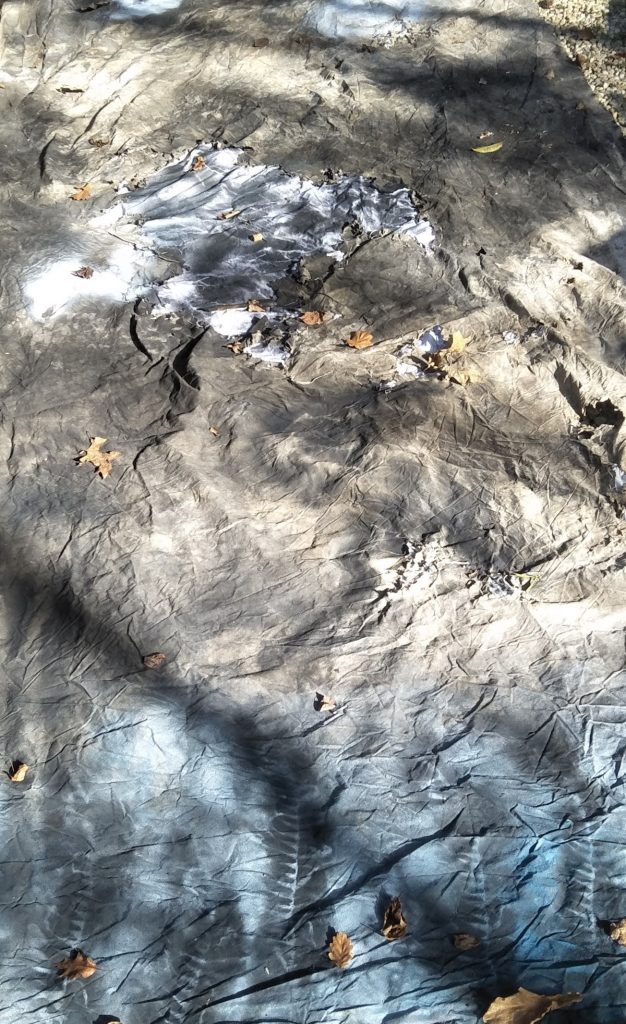Connecting listening and collaborating with Land through Art
Bärbel Ullrich
Full text | PDF
I wish to acknowledge the Duduroa and the Jaitmathang people, the traditional custodians of the land on which I have the privilege of living and producing artworks from, and I pay my respects to the Elders. past, present and future.
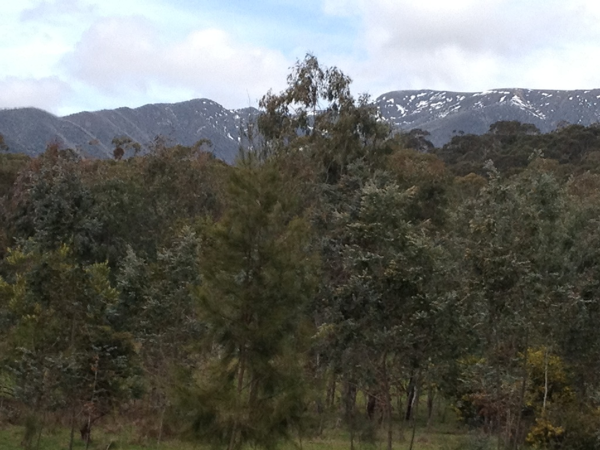 Bärbel Ullrich: Photograph
Bärbel Ullrich: Photograph
Abstract
The tradition of ‘landscape’ painting in Australia is evolving as our culture, religious beliefs and attitudes about land, our place and our relationship to it is changing due to ecological crisis, global warming and climate change. I believe that what is important today is the creation of a new human spiritual relationship to land/nature and the non-human world.
In my land-based art work, which focuses on my property under Mount Bogong in Victoria, I am searching for new ways of looking at and visually interpreting the Australian natural environment that breaks with European pictorial conventions – such as ‘framing’ a landscape, controlling a view, power over nature. This search is for a spiritual connection with space and place – spiritual belonging. I have worked in collaboration with nature/land and have created images from and with/within the landscape rather than of the landscape. My process is to interact and listen to the environment. I leave the canvas/paper out in the weather, buried using materials found in the environment such as dirt, water and charcoal. After a period of time, I take the work back to the studio and build up layers with overprinting, drawing and collaging.
By recording different layers, surfaces, observations, visual diversities and complexities – an ecological palimpsest of the experience of the land is created. This contributes to the emerging sense that we are not separate from the environment but we are all part of a greater whole and need to rethink our ecological ethics.
Keywords
Photography; Land; Connecting; Listening; Environment
Introduction
The tradition of landscape painting in Australia is evolving as our culture, religious beliefs and attitudes about land, our place and our relationship to it is changing due to ecological crisis, global warming and climate change.
I believe that what is important today is the creation of a new human spiritual relationship to land/nature and the more-than-human world. Joseph Campbell believes that there is a need in our time for a general transformation of consciousness where we can live in harmony and peace in accord with the creative energies of nature (Gimbutas, 1989).
In my land-based art work, which focuses on my property under Mount Bogong in Victoria, I am searching for new ways of looking at and visually interpreting the Australian natural environment that breaks with European pictorial conventions – such as framing a landscape, controlling a view, power over nature. This search is for a spiritual connection with space and place – spiritual belonging. I have worked in collaboration with nature/land and have created images from and with/within the landscape rather than of the landscape. My process is to interact and listen to the environment. I leave the canvas/paper out in the weather, buried using materials found in the environment such as dirt, water, oxide and charcoal. After a period of time, I take the work back to the studio and build up layers with overprinting, drawing and collaging.
By recording different layers, surfaces, observations, visual diversities and complexities – an ecological palimpsest of the experience of the land is created. This contributes to the emerging sense that we are not separate from the environment, but we are all part of a greater whole and need to rethink our ecological ethics.
The human world and the more-than-human world are still seen and experienced as separate entities. Today the new field of Environmental Humanities challenges us to rethink or remake nature and to reframe contemporary challenges.
There is a recognised need to consider and create new narratives about how humans and the environment relate to one another. New ideas about nature are emerging and how these shape environmental issues (UNSW, 2012). In my work I have used ideas that emerge from ancient themes of mythology as well as archetypal motifs to convey a contemporary sense of a spiritual belonging and oneness and interconnection with the environment.
‘Myth’ and ‘Mythology’
Myth helps you put your mind in touch with this experience of being alive. Myths are clues to the spiritual potentialities of the human life and what we’re capable of knowing and experiencing within (Campbell, 1988, p. 5).
The term Myth is a fundamental and difficult subject. The Jungian view is that all mythologies come from the deep collective unconscious and are connected through the recurrence of archetypal symbols. The iconography of the Goddess arose in reflection and veneration of the creative energies of nature.
Ancient themes and motifs of mythology and their commonality can be seen in the creation stories and images throughout many cultures which point to a constant requirement in the human psyche for a centering in terms of deep principles. The mystical and timeless cycle of death, burial and resurrection can be reflected in the metaphor of the seed which became the magic symbol of this endless cycle (Moyers in Campbell, 1988). I use this symbol in my work which has multivalent meanings in the form of the circle.
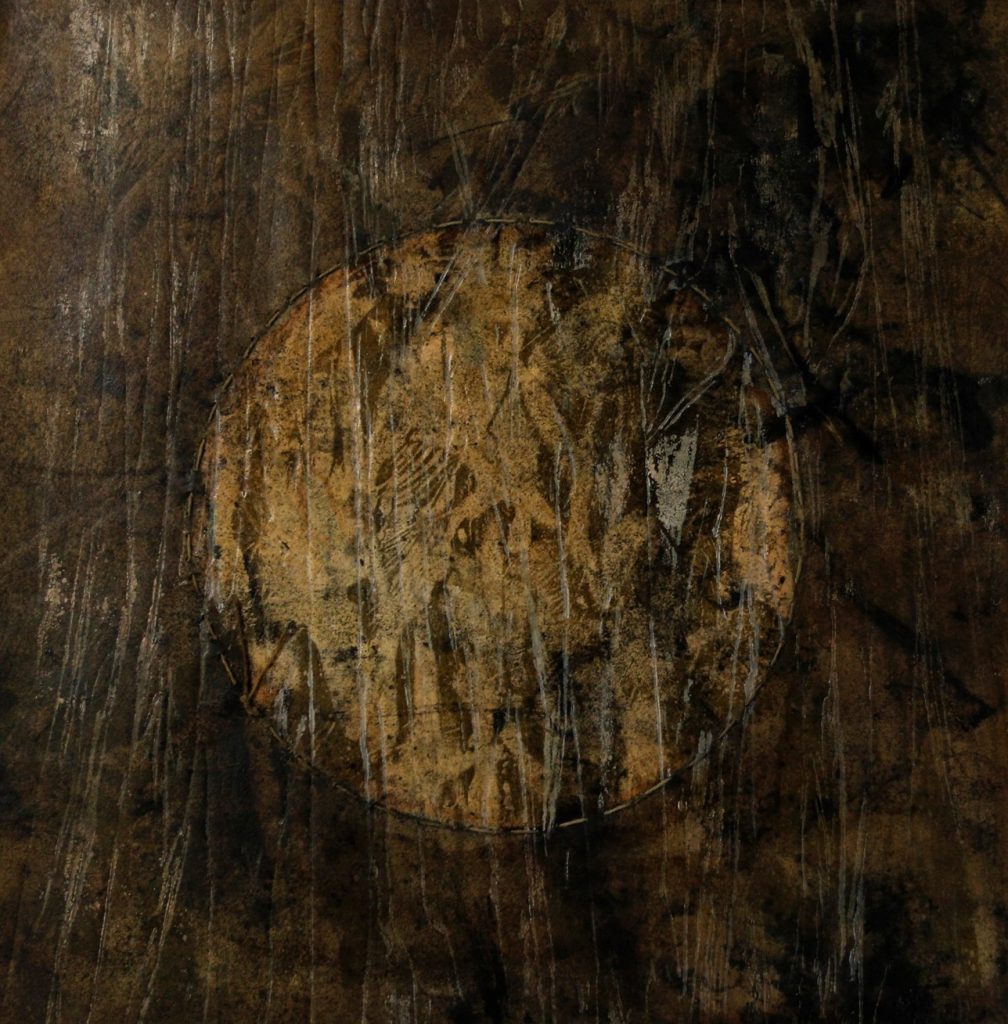 Bärbel Ullrich: From the Earth Print series, 2016, mixed media print, 53x53cm
Bärbel Ullrich: From the Earth Print series, 2016, mixed media print, 53x53cm
There is a primordial attempt on humanity’s part to understand and live in harmony with the beauty and wonder of creation, and this can be expressed in archetypal symbolic forms. Mythology also involves listening to your inner self and responding to the stories and archetypal symbols in a deep personal way. Campbell believes that the definition of myth is more than a search for meaning but an experience of meaning.
The principle myth that informs my work is the idea of Gaia. The Gaia hypothesis is an alternative to that pessimistic view which sees nature as a primitive force to be subdued and conquered (Lovelock, 1995). The new science of Gaia is called geophysiology. It is the idea of the Earth as a kind of living organism, something able to regulate its climate and composition so as always to be comfortable for the organisms that inhabit it. The idea of Mother Earth or, as the Greeks called her, Gaia, has been widely held throughout history and has been the basis of a belief that coexists with the great religions (Lovelock, 1995).
Deborah Bird Rose says that Country or the “nourishing terrains”, are the active manifestation of Creation where “everything in the world is alive: animals, trees, rains, sun, moon, some rocks and hills, and people are all conscious” (Rose, 1996, p. 23). This resonates with my personal philosophy and my approach to working in collaboration with land.
Marija Gimbutus’ work in her books The Language of the Goddess and The Goddesses and Gods of Old Europe: Myths and Cult Images, seeks to identify the Old European patterns of Goddess religion. Her research is an important legacy for today’s ecological thinkers. For Gimbutus, the power of the feminine and the earth is revered in ancient, primal and pagan mythologies, where archetypal symbols are the main lines and themes of a past religion that is in veneration of the universe as the living body of a Goddess-Mother Creator, where all living things within it are partaking of her divinity. Again, we cannot restore these mythologies in their original contexts, but through our thinking about our relationship to the environment, we can restore their attempts to balance between male and female energies. Reverence and respect for the female principle should contribute to a spiritual shift toward balance with the Earth.
Christian mythology that borrowed many of the symbols, rituals and festive seasons from pagan mythology has denied or excluded earth, nature, woman and body as sacred entities. The male principle and sky god are prioritised while the earth goddess is vanquished. It is through history, interpretation, culture, thought patterns and beliefs that this has occurred and allowed to perpetuate. Dualities in Western thinking – human/nature, God/man, God/nature, male/female, good/evil, culture/nature. – have occurred where one dominates the other (Gimbutas, 1989).
There is a need now to transform the way we exist in the world and Indigenous Australian Spirituality can be a guiding code or a seed for the next cycle of regeneration/rebirth, where humanity is reintegrated with the earth and the living spirit of the natural world. This view is reinforced by Deborah Bird Rose’s concluding chapter. She states:
Visions of the holistic Earth, combined with the rapidly increasing understanding of how badly she is being damaged, forces us to confront difficult questions. How do we, as individuals, assert our right to take responsible care of the systems with which we interact and on which we are dependent? What wisdom have we inherited, what systems and knowledge do we bequeath to the future? (Rose, 2000, pp. 233-234)
David Tacey says that Nature “is not only outside us but also within, and ultimately, what we do to nature we do also to ourselves… In killing off the spiritual essence of the Earth, we end up killing ourselves, for this essence nourishes our own biological and spiritual life” (2000, p. 168). I agree with Edward O Wilson who says that “only by discovering the ancient symbols can the artist express meanings that cross generations and open the full abundance of nature” (1984, p. 80). Through the use of these symbols, we can communicate the sacredness and the mysteries of nature rather than just a mimetic surface appearance as represented by European pictorial traditions. My work expresses and reflects my connection to land, the sacredness of land and spiritual belonging, and articulates my processes to inform that knowledge.
New Environmental Humanities and Eco Philosophy
The human world and the more-than-human world are still seen and experienced as separate entities. Today the new field of Environmental Humanities challenges us to rethink or remake nature and to reframe contemporary challenges. There is a recognised need to consider and create new narratives about how humans and the environment relate to one another. New ideas about nature are emerging and how these shape environmental issues (UNSW, 2012). Environmental Humanities is part of a growing willingness to engage with the environment from within the humanities and social sciences. It positions us as participants in lively ecologies of meaning and value, entangled with rich patterns of cultural and historical diversity that shape who we are and the ways in which we are able to “become with” others (UNSW, 2012).
As a land-based artist it is important for me to be aware of this ontological shift in our relationship with nature, as it would include new representations of environment expressing that relationship and a departure from the modernist view of representation where the artist is separate from nature. In this sense my argument would be that traditional pictorial representations of landscape are inadequate for today’s new environmental thinking, as they place the artist and the viewer as separate from the landscape.
Eco Philosophy explores fundamental questions concerning the relationship between human thought, language (pictorial language) and the wider environment. It not only resituates humans within the environment but it also resituates non-humans within cultural and ethical domains. It aims to overcome the nature/culture binary that positions humans outside of nature, which implicitly posits that we are free to control our own destiny within a broader natural world that is devoid of meaning, value and ethics (UNSW, 2012). The idea of nature as dead matter is part of the human/nature dualism entrenched in our Western culture. It represents nature as passive and uncreative where more-than-human forms are emptied of agency, spirit and intelligence (UNSW, 2012).
Timothy Morton says that one of the basic problems with nature is that it could be considered either as substance, as a “squishy” thing in itself, or as essence, as an abstract principal that transcends the material realm and even the realm of representation (2007). If we consider nature as substance there is the assumption that it is outside of ourselves so we need to consider ourselves as part of that substance. From walking alone in the bush, I feel that nature, the environment does have an essence, a transcendent force that relates to our spiritual connection with the environment and our sense of wonder and awe.
This idea relates to the term animism where the older usage of the term alleges to a belief in spirits that are embodied in creatures, nature or natural objects and places, and that all things in natural phenomena and the material universe have a soul. The newer usage is now an important term for describing ways in which some people understand and engage respectfully with the larger-than-human world. It recognises that the world is full of person’s only some of whom are human, and that life is always lived-in relationship with others. It refers to the “widespread indigenous and increasingly popular ‘alternative’ understanding that humans share this world with a wide range of persons, only some of whom are human” (Harvey, 2017, pp. xiii-xv).
The Axis Mundi
An ancient tree which represents symbolically the growth and development of psychic life: I have used the axis mundi in the series The Sacred Moon Tree (I-VII) as a visual and symbolic structure throughout the work, however subtle and ambiguous. The axis mundi is a symbol that links heaven and earth or is a vehicle to communicate with the two. It is also the symbol of the centre, the still point around which the seeming chaos or movement of the universe revolves. It is also symbolised as a cosmic tree, the tree of life or a mountain. It is an ancient tree or plant that symbolically represents the growth and development of psychic life. As a centre it could also be interpreted as a mandala (Jung, 1978).
Mircea Eliade states that the axis mundi is an image of a universal pillar through which the three cosmic levels – earth, heaven, underworld – have been put in communication. The axis mundi connects and supports heaven and earth and whose base is fixed in the world below. He says that such a cosmic pillar can be only at the very centre of the universe, for the whole of the habitable world extends around it. It is the Centre of the World or the navel of the earth, the symbolism of which marks a sacred place or precinct. It can be a cosmic or sacred mountain, a holy site, a temple, a tree or a vine where the axis is located at the centre and the sacred is manifest. It turns chaos into cosmos (1987).
The sacred reveals absolute reality and at the same time makes orientation possible; hence it founds the world in the sense that it fixes the limits and establishes the order of the world (Eliade, 1987, pp. 36-38).
I believe the axis mundi is a primal archetypal symbol – both spiritual and psychological. It is embedded in mythology, both Christian and pagan, and inherent in the collective unconscious but is dominantly hidden or forgotten in our materialistic culture. I interpret the symbol metaphorically to connect the physical realm (earth) and the spiritual realm (heaven) with the soul/creative force being the centre. Thus, the orientation is metaphysical and the axis mundi as such is a key to the understanding of our spiritual belonging to the earth.
 Bärbel Ullrich: From the Sacred Moon Tree series, 2016, mixed media print, 53x53cm
Bärbel Ullrich: From the Sacred Moon Tree series, 2016, mixed media print, 53x53cm
The axis mundi is not only a symbol, but for me is a significant way of working (methodology) as an artist. I interact with the environment and work from intuition – letting things happen and materialise from within the centre. In my studio practice I have aimed to be open to experiences of nature as powerful, agentic and creative. I have allowed nature to contribute to the artwork being a collaborator in the process. By partially burying the paper, or canvas, or placing organic matter on the surface and sprinkling oxide over the top, then leaving the work out in the weather for periods of time, creates marks and traces that become fractals and patterns generated by the environment. I therefore relinquish total control and these works can then be overprinted with plates made from materials of the environment.
 Bärbel Ullrich: works in process with the environment
Bärbel Ullrich: works in process with the environment
Collaboration with nature. On walking as a process (while listening to the sounds of the environment).
The concept of walking for engagement with the natural environment and a connection with nature to experience place and space is important for my interaction and collaboration with the environment. It gives me the experience of being alive on a purely physical plane but also has resonances in my own innermost being and reality.
I believe that ‘listening’ is an active process combined with walking involving paying attention, engaging and interacting with the more-than-human world. It is a way of communicating and connecting with the environment and the multitude of Earth language – the sounds, smells, behaviour, the flowering trees, the seasons, and the comings and goings of birds, insects and other creatures, and the silences too.
The concept of engagement with the natural environment
Focuses on the bodily experience of walking, where walker consciously and unconsciously engages and interacts with discernible and indiscernible features of the places through which they walk. The interaction is much more than contemplation led by the eyes. Multiple senses are alert, and the feet play an important sensory role. Walking is described as a co-creation, a discourse between internal bodily rhythms and the rhythms and features of place. … [the suggestion] that in some circumstances walking may help people develop affinity with place, and that in some circumstances people will be acted on through walking and readied for personal change, which may be an enhanced engagement with natural environments more generally (Simmons, 2016, pp. 25-26).
For a holistic connection with land/nature and a sense of spiritual belonging to place we need to break down the divisions between humans and nature – this can be achieved not only through arts practice where the artist ‘collaborates’ with nature to produce the work but also through walking. Simmons presents the notion that walking in natural environments can influence a walker’s relationship with natural environments. The potential for one way of knowing about the natural environment that is socially and bodily available to most humans is walking (2016).
Walking is “a multisensory interaction of internal and spatial rhythms” and a “multisensory experience of immediate locale, and a coproduction between body and place” (Simmons, 2016, p. 24). Thus, walking can produce a sense of place as well as a connection and direct experience with the spatial environment – it stimulates multiple senses, sound, smell, imagination and can even stimulate anxiety – being alone and isolated in the bush. Walking can be linked to the ‘embodied experience’ mode of interaction with the environment where the walker is connecting the body with place – the body acts and is acted upon through the journey (Simmons, 2016).
On the use of printmaking to collaborate with the environment and create images
I have used printmaking as a primary method for the creation of images based on land/environment. It is a collaboration and a synthesis of artist, process, subject matter, emotion, materials, techniques and nature. The preparation of plates, predominantly collagraph, but also using dry point, lino-cut and etching, includes working with the environment. For example, the collagraph plates are made by either gluing down natural materials or coating the plate with no more gaps, covering with glad wrap and placing the materials on top of this then weighting them down to get an impression.
With printmaking everything is a bit of a surprise – the artist has to relinquish total control of the process and allow for chance, experimentation, variation in marks and techniques as a means of expression. Accidental effects might change the experience and the outcome. Nature is in constant change and flux and this can be expressed/represented through the printmaking process. Contrary to prints being made in the studio with mechanical processes, they can also be made in the environment where nature imprints its energy, flux and patterns onto the paper with natural materials and through the process of time.
 Bärbel Ullrich: collagraph plate 2016
Bärbel Ullrich: collagraph plate 2016
On the Use of Archetypal Symbols in my Work
The Circle
The circle (or sphere) is a symbol of the self. “It expresses the totality of the psyche in all its aspects, including the relationship between man/woman and the whole of nature.” However, the symbol of the circle is used, in art or ritual, it always points to the single most vital aspect of life – its ultimate wholeness (Jung, 1978, p. 266). The symbolic alchemical concept of the squared circle is a symbol of wholeness and of the union of opposites. The square is a symbol or earthbound matter, or the body and reality (Jung, 1978). The circle is a multivalent symbol that includes the self, unity, moon, sun, earth, stones, seeds, axis mundi, mandala, the spiral. Its image can be seen in natural forms in the environment.
Stones
Unhewn stones had a highly symbolic meaning for ancient societies. Jung noted that “Rough, natural stones were often believed to be the dwelling places of spirits or gods, and were used in primal cultures as tombstones, boundary stones, or objects of religious veneration” (Jung, 1978, p. 258). They invested the stone with more expressive power than chance and nature could give it.
The site (the specific area where I was working) contains massive stones which would have been moved by the force of water over the aeons. Two creeks meet at the base of three large hills. At this point of the creek intersection there is a huge stone, now covered in moss and lichen. When I first discovered it, it had some markings in it. The markings represented a triangle (natural or human made?) – an archetypal symbol. It is now overgrown with moss and I am reluctant to disturb it. These types of stones could be known as ‘omphalos’ which are conical stones, representing the central point of the earth (Dent, 2013). Stones and mountains are among the oldest symbols of the Great Mother Goddess (Magon, 1995).
I have used images of stones in my work as they are not only an archetypal symbol but a predominant aspect of the site and are related to the creek environment. They also reflect a sense of permanence in the environment which is in a constant state of flux and change. The stone symbolises what is perhaps the simplest and deepest experience – the experience of something eternal which a person can have in those moments when he/she feels immortal and unalterable.
Rocks in many ancient cultures are invested with sacred powers and for this reason can be used as instruments of worship (Eliade,1976, p. 216). Stones represent the symbolic habitat of a spirit and they become sacred because they bear the mark of some spiritual force (Eliade, 1976). They are signs always representing something beyond themselves and always signifying something greater than mankind (Eliade, 1976). I am always in awe of large stones – there is an aspect of the sublime within their profound mass and permanence.
The Spiral
Time itself is cyclic, and by the spiral of its returning seasons we review the progress and growth of our own understanding (Purse, 1997). The spiral is a symbol, it denotes eternity. The universe and human consciousness (the macrocosm and the microcosm) consist in a continuum and a dynamic whole – this can be expressed by the spiral. This symbol, which is perpetually turning in on itself, expanding and contracting, has an interchangeable centre and circumference, and has neither beginning or end – the spherical vortex. The spherical vortex has analogies in nature – the form of flow created by air and water (Purse, 1997).
Archetypal flow and growth form – microcosm & macrocosm – spiral movement creates a centre. Water is the pure, potential and unformed matrix from which all life takes its being – ephemeral but changeless configurations – an order, kosmos, Greek for order – matter has movement and organisation. The growth or human consciousness is the continuous refining of its own organisation, the ordering of its individual microcosm – we are the spiral and all the spirals within (Purse, 1997).
The Mandala
This is a Hindu term for circle. It is a kind of yantra (instrument, means or emblem), in the form of a ritual geometric diagram, sometimes corresponding to a specific, divine attribute or to some form of enchantment (mantra) which is thus given visual expression. They are to be found all over the Orient, and always as a means towards contemplation and concentration – as an aid in inducing certain mental states and in encouraging the spirit to move forward along its path of evolution from the biological to the geometric, from the realm of corporeal forms to the spiritual (Jung, 1978).
No one mandala is the same as another, all are different because each is a projected image of the psychic condition of its author, or in other words, an expression brought about by this psychic content to the traditional idea of the mandala. Thus, the mandala is a synthesis of a traditional structure plus free interpretation. Its basic components are geometric figures, counterbalanced and concentric. Hence it has been said that “the mandala is always a squaring of the circle” (Jung, 1978).
The mandala is, above all, an image and a synthesis of the dualistic aspects of differentiation and unification, of variety and unity, the external and the internal, the diffuse and the concentrated. It excludes disorder and all related symbolisms, because, by its very nature, it must surmount disorder. It is, then, the visual, plastic expression of the struggle to achieve order – even within diversity – and of the longing to be reunited with the pristine, non-spatial and non-temporal Centre, as it is conceived in all symbolic traditions (Girlot, 1967, p. 90).
In Jung’s view, mandalas and all concomitant images are derived from dreams and visions corresponding to the most basic of religious symbols known to humankind – symbols which are known to have existed as far back as the Palaeolithic Age. The juxtaposition of the circle, the triangle and the square (numerically the equivalents of the numbers one and ten; three; and four and seven) plays a fundamental role in the most classic and authentic of oriental mandalas. Jung suggests that the mandala represents an autonomous psychic fact, or “a kind of nucleus about whose intimate structure and ultimate meaning we have no direct knowledge” (1997, pp. 284-285). The mandala can also be seen as an objective symbol, an imago mundi (the centre, a fixed point, the creation of the world) rather than a projection of the mind, without, however, discrediting the latter interpretation (Jung, 1978).
On the use of stitching
The washing of the cloth is a symbol for cleansing and purification. In mythology the woven cloth is the work of the Life/ Death/ Life mothers. To wash something is a timeless purification ritual. It not only means to purify, it also means – like Baptism from the Latin baptiza – to drench, to permeate with a spiritual numen and mystery (Estés, 1998).
The symbolism of binding and knotting is related to mending and healing and also has magical connotations. Binding and knotting also have universal spiritual connotations. In many countries the thread of life symbolises human destiny. The goddesses of fate spin the thread of human life. The cosmos itself is also conceived as a tissue, as a vast web. In Indian speculation the air has woven the Universe by linking together this world and the other world and all beings, as it were by a thread, just as the breath has woven human life. In the Cosmos as well as in human life, everything is connected with everything else in an invisible web. Certain divinities are the mistresses of these threads which constitute, ultimately, a vast cosmic “bondage” (Eliade,1991).
Thus, the thread or the cord in mythology symbolises the cosmic principle that unites all things and also the support, the power and the divine law that hold the universe together. The labyrinth is sometimes conceived as a knot that has to be un-tied, and this notion belongs to a metaphysico-ritual unity which comprises the ideas of difficulty, of danger, of death and of initiation. Thus, key words conveying the idea of “bondage”, “shackling”, “attachment” and the idea of binding appear on magical and religious planes and are a complex archetypal symbol of human’s recognition of their own situation in the world (Eliade, 1991). Plaiting, weaving, binding and knotting become the repository of transformation and in the primordial mysteries they lay the foundations of human culture (Magon, 1995).
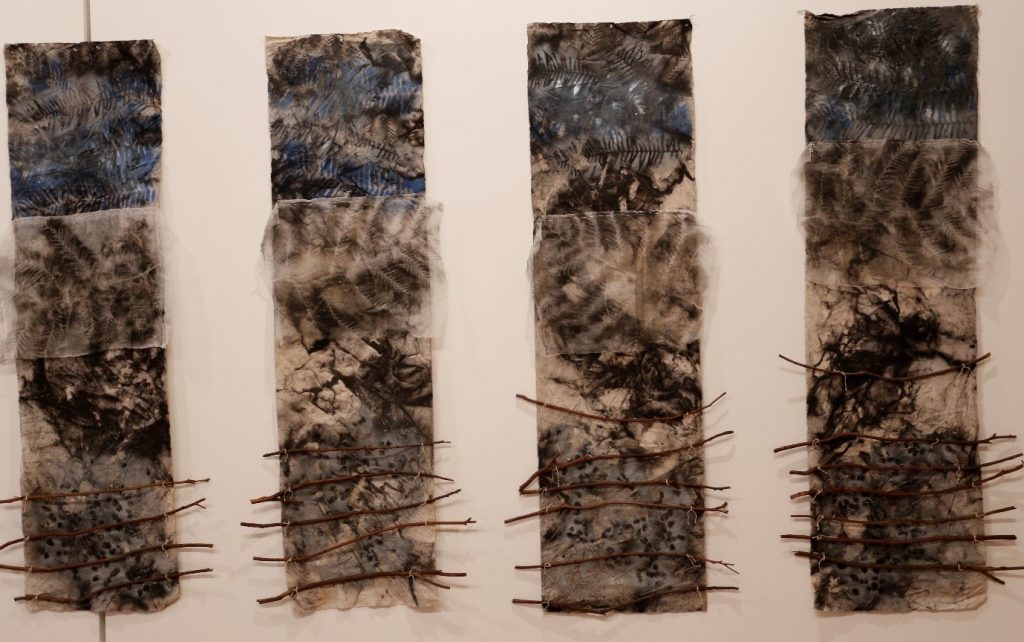 Bärbel Ullrich: From the series of 7 Sticks, Rocks and Ferns, Mixed Media on canvas, 2017
Bärbel Ullrich: From the series of 7 Sticks, Rocks and Ferns, Mixed Media on canvas, 2017
On the use of the number 7.
To symbolically suggest a sense of spirituality in my work, I have created works in series of seven. The number seven represents for me, the four compass points, looking up (sky/heaven) and looking down (earth) and the centre, the soul/spirit.
I have also discovered that the number seven has many references in the Bible. It is the number of completeness and perfection, both physical and spiritual. Seven derives much of its meaning from being tied directly to God’s creation of all things, whereas I would interpret it as the embodiment of the feminine earth-bound spirit and the interconnectedness of all things rather than a product of the creation of a celestial male deity. There are seven days in the week and God’s Sabbath is on the seventh day. The Bible as a whole was originally divided into seven major divisions, the seventh one being the Book of Revelation. The total number of originally inspired books was forty-nine, or seven by seven, demonstrating the absolute perfection of the Word of God. In the Book of Revelation there are seven churches, seven angels to the seven churches, seven seals, seven trumpets, seven thunders and the seven last plagues. Jesus performed seven miracles on God’s holy Sabbath day and Jerusalem is a city of seven hills (http:www.biblestudy.org/bibleref/meaning-of-numbers-in-bible/7.html retrieved, 2018).
Also, there are seven colours of the rainbow – red, orange, yellow, green, blue, indigo and violet. The rainbow is a symbol that makes visible the hidden energies that stir earth and animals to fertility. It represents magnetic energy and invisible forces. The rainbow as seen from the sky looking down is a circle. The Rainbow serpent in Australian Indigenous mythology is linked to the earth’s magnetic fields. She extinguishes and recreates life and holds all original ancestors of the Dreaming in her stomach (Lawler, 1991).
The Shroud of Darkness
The Shroud of Darkness was created in dedication of the Earth and the acknowledgement of the destruction that humankind has created on this planet. It has positive and negative connotations. As David Tacey says that terror is an “archetypal disposition” which has “blocked psychic energy” (2013, p. 19). He believes that Jung’s work becomes more appreciated as our intellectual development moves toward ecological, integrative and holistic values. My belief which is reinforced by Tacey is that we are in need of an integral view of reality that includes the spiritual (2013). Tacey says that
The paradox of Jung’s psychology is that to get to the source of light, the self, we have to go via the darkness of the unconscious with its repressed instincts and drives. There can be no avoiding this unpleasant encounter with the shadow. …the human species has been moving on an unecological and self-destructive course. The ecology of spirit, mind and body have been cut out of balance in the patriarchal system (2013, pp. 67, 80).
Conclusion
Today we are experiencing upheaval, suffering, strife and conflict. The Shroud of Darkness is a metaphor that initiates the movement toward consciousness through images of light and dark. It has a positive connotation where unity and the original wholeness can be regained – a universal awareness.
I spend a lot of time sitting still in the bush and practicing deep listening while looking for information. When walking or just sitting – our brains are full of other information removed from where we are. We need to shut our brains down and become aware of the place we are in. Through listening and mindfulness, we become more engaged with the present moment in our lives. Mindfulness helps us to intentionally cultivate an attitude of curiosity and interest which engages us in our senses and brings us fully into the present moment. When we feel stressed or overwhelmed it is important to punctuate the day with brief pauses. To stop, feel our feet on the ground and take a few deep breaths (Monash, 2017).
It has been through such methodologies that I have felt a connection with the land, through the practice of making with, and being in and with land, but also by engaging with the archetypal symbolism which has transcended time and cultural spaces – Spiral, Mandala, Stones, Circle and Axis Mundi. These experiences of land and making with archetypal symbols of land has enhanced my experience of our interconnectedness as humans with the-more-than human world and has further connected me with this land.
We need to see and think differently to enter into a new relationship or connection with nature – which is really our own self. We have an arrogance that the world is for us – our resources – that we cannot become extinct – this anthropocentric view needs to be changed and humbled. Thoughts and emotions are a form of psychic energy. If we can change our thoughts to creative positive energy and creatively engage with the land and our environment our collective thinking may gradually change the world in which we live.
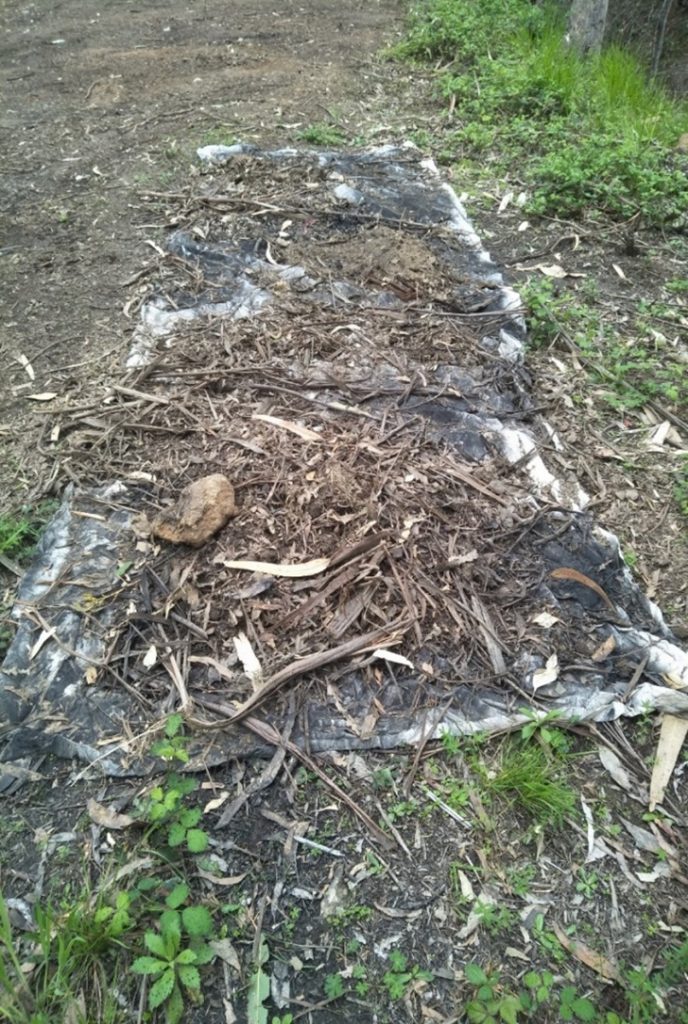 Bärbel Ullrich: The Shroud of darkness, 2020, Mixed media on Canvas. 510 x 170cm (in progress)
Bärbel Ullrich: The Shroud of darkness, 2020, Mixed media on Canvas. 510 x 170cm (in progress)
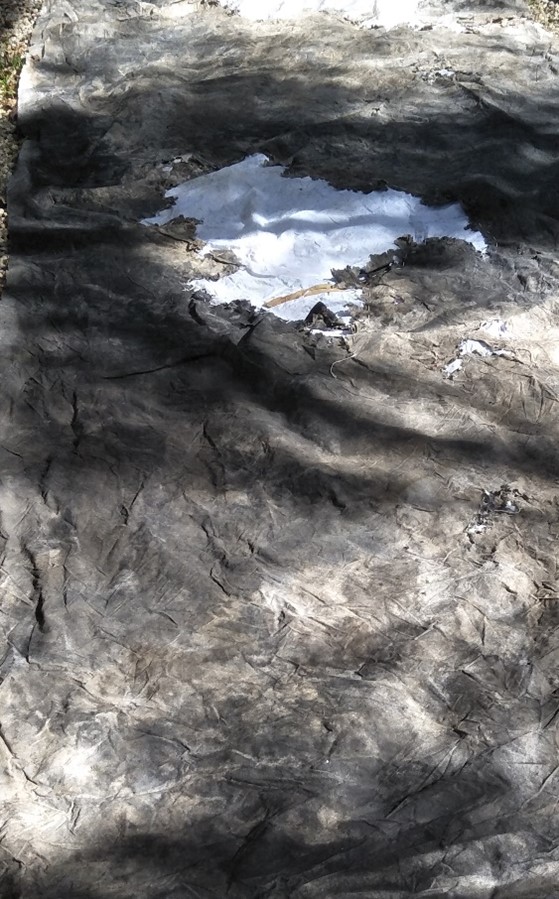 Bärbel Ullrich: Images below details, The Shroud of darkness, 2020, Mixed media on Canvas. 510 x 170cm (Details)
Bärbel Ullrich: Images below details, The Shroud of darkness, 2020, Mixed media on Canvas. 510 x 170cm (Details)
References
Campbell, J. (1988). The Power of Myth with Bill Moyers. Doubleday.
Dent, S. (Ed). (2013). Brewer’s Dictionary of Phrase and Fable. (19th ed) Chambers Harrap Publishers.
Eliade, M. (1976) Patterns in Comparative Religion. Shead and Ward.
(1987). Translated by Trask, W A. The Sacred and the Profane. The Nature of Religion. The Significance of Religious Myth, Symbolism, and Ritual within Life and Culture. Hardcourt Brace & Co.
(1991) Images and Symbols: Studies in Religious Symbolism. Princeton University Press
Estés, C. P. [1992] 1998. Women Who Run with the Wolves: Contacting the power of the Wild Woman: Random House.
Gimbutas,M. (1989). Forward by Campbell, J. The Language of the Goddess. Thames & Hudson.
(1982) The Goddesses and Gods of Old Europe. Myths and Cult Images. Thames & Hudson.
Girlot, J.E. (1967). A Dictionary of Symbols. Routledge.
Harvey, G. (2017). Animism: Respecting the Living World. (2nd ed) Hurst & Company.
Jung, C. (Ed). (1978). Man and his Symbols. [Orig, 1964] Aldus Books.
Lawler, R. (1991). Voices of the First Day: Awakening in the Aboriginal Dreamtime. Inner Traditions.
Lovelock, J. (1995). Gaia, A New Look at Life on Earth. (4th ed). Oxford University Press.
Magon, J. (1995). Anneke Silver: Images of the Goddess and Nature Mysticism. Craftsman House.
Meaning of Numbers in Bible. http:www.biblestudy.org/bibleref/meaning-of-numbers-in-bible/7.html
Monash University. (producer). (2017). “Mindfulness for Wellbeing and Peak Performance” [MOOK] https://www.futurelearn.com/courses/mindfulness-wellbeing-performance/1
Morton, T. Ecology Without Nature: Rethinking Environmental Aesthetics. Harvard University Press. 2007.
Purse, Jill. (1997 reprint). The Mystic Spiral: Journey of the Soul. Thames & Hudson.
Rose, D. B. (2000) Dingo Makes us Human: Life and Land in Australian Aboriginal Culture. Cambridge University Press.
(1996). Nourishing Terrains: Australian Aboriginal Views of Landscape and Wilderness. Australian Heritage Commission, 1996.
Simmons, P. (December 2016). “Walking as Bodily Readying for Engagements with Natural Environments” in Land Dialogues: Interdisciplinary Research in Dialogue with Land. Fusion Journal Issue 10, CSU.
Tacey, D. J. (2013) The Darkening Spirit: Jung, Spirituality, Religion Routledge, 2013
(2000) ReEnchantment: The New Australian Spirituality. Harper Collins.
UNSW Sydney (producer) (2012) “Environmental Humanities: Remaking Nature” [MOOC] https://futurelearn.com/courses/remaking-nature
Wilson, E. O. (1984) Biophilia: The Human Bond with other Species. Harvard University Press.
About the Author
Bärbel Ullrich is a visual artist/printmaker who lives in a property at the foothills of Mt Bogong in Victoria, Australia. Her current project is working in collaboration with the environment to produce prints that imbue the spirit of place. She states: “I have deliberately chosen to create site related works from ‘my place’ as it is where I live and where I feel I have a strong spiritual connection. Through this work I have aimed to understand myself and my artistic practice in greater depth as well as getting to know the ‘bush’ environment surrounding my home dwelling.” Bärbel interacts with and uses material from the environment. The concept that everything is alive is an important philosophy that underlies and informs her work.
To cite this article
Ullrich, Bärbel. “Connecting listening and collaborating with Land through Art.” Fusion Journal, no. 19, 2021, pp. 21-41. http://www.fusion-journal.com/Connecting listening and collaborating with Land through Art/
First published online: March 2021



 Bärbel Ullrich: photographs
Bärbel Ullrich: photographs Bärbel Ullrich: photograph
Bärbel Ullrich: photograph


